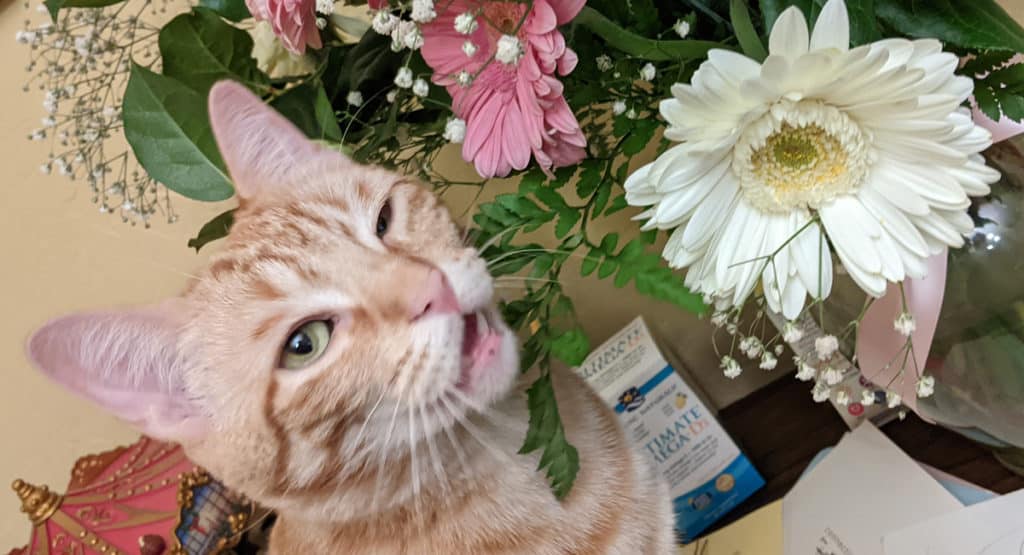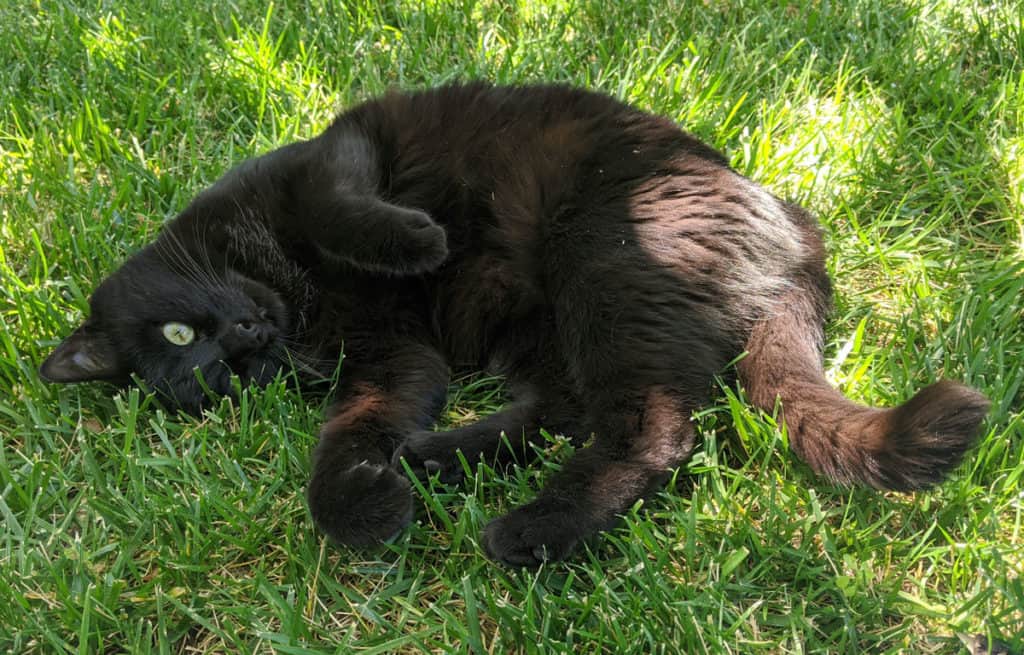Just like humans, cats have their way of communication. From their body language to using vocals, your cat will use multiple signs or signals to communicate. Another way that cats communication is through the use of chemicals that are spread when the cat rubs up against another cat, person, or object. Undetectable to humans, cat pheromones are natural substances that help cats share certain information with other cats.
What are cat pheromones?
Pheromones are a chemical form of communication that cats use to interact with one another and with their surroundings.. These chemicals, often undetectable by humans, are a critical part of non-verbal communication in the animal kingdom. In cats, pheromones serve various functions, including marking territory, signaling reproductive status, and conveying emotional states.
Pheromones are detected by an organ located in the roof of a cat’s mouth, known as the vomeronasal organ (VNO) or Jacobson’s organ. When a cat is exposed to a pheromone, it often exhibits a behavior known as the Flehmen response, where the cat curls back their lips and opens their mouth to better analyze the scent.

How do cats release pheromones?
When your cat rubs against you, it’s actually using special glands to leave chemical signals on your body. These chemicals provide information to other cats and are important for their survival.
Cat pheromones are released from specific glands found around their bodies. The majority are located around their face – including the lower ears, chin, cheeks, forehead, and near the mouth. Additionally, cats have scent glands in their paw pads, and female cats have them around their nipples. Other important scent glands are found in their urine and near their anal area.

Types of Natural Cat Pheromones
- Facial Pheromones: Cats have scent glands on their cheeks, forehead, and chin. When they rub their face against objects, humans, or other animals, they are depositing facial pheromones. These pheromones are generally associated with feelings of comfort and familiarity. They are often used to mark territory as safe or familiar.
- Territorial Pheromones: Found in the urine, these pheromones are used primarily for marking territory. When a cat sprays urine, it is communicating their presence and establishing boundaries.
- Maternal Pheromones: Produced by mother cats, these pheromones help to calm and reassure kittens. They play a crucial role in the bonding process between a mother and her offspring.
- Agonistic Pheromones: These are associated with aggression and stress. They are often released in response to a threat or discomfort, signaling other cats to stay away.
Ways that a cat might spread pheromones includes:
- Rubbing head on humans or objects in the house
- Claw or Scratch at items
- Bump their heads on each other
- Rub their bodies on objects and surfaces
- Spray to mark their territorial areas
Does the use of artificial cat pheromones work to calm cats?
Recent research has explored the use of synthetic pheromones in managing cat behavior and reducing stress. Products mimicking facial pheromones are used to help cats adapt to new environments, reduce stress-related behaviors, and improve interactions between multiple cats in a household. Nowadays, artificial pheromones are found in boarding facilities, veterinarian offices, catteries, zoo, and multi-cat households. Pheromones are even available at pet stores. But do they work?

One survey analyzed available research on the use of pheromones in dogs and cats done between January 1998 through December 2008. Published in 2010 in the Journal of the American Veterinary Medical Association, the study authors found “Studies provided insufficient evidence of the effectiveness of feline facial pheromone for management of idiopathic cystitis or calming cats during catheterization and lack of support for reducing stress in hospitalized cats.” However, this study was very small – only 14 studies were found that met the criteria of the research and only seven of those involved the use of pheromone therapy in cats.
Another study, published in Pesquisa Veterinária Brasileira in 2017, looked at the cortisol levels (a hormone that rises with stress) in the saliva of cats before after after being treated with a Feliway Classic F3 diffuser for 35 days. Of the 28 cats in the study, 21 responded with lower levels of cortisol. Interestingly, all seven of the cats that did not respond were female.
A randomised, double-blind, placebo-controlled clinical trial looked at the calming effect of Feliway spray versus a placebo spray on 87 cats that were being examined in a veterinary office. The study found that using Feliway spray changed cats’ normal behavior in a noticeable way, according to their owners. Cats exposed to Feliway were less stressed compared to those given a placebo. However, when it came to how easily the cats were handled, there was no significant difference between the cats treated with Feliway and those given a placebo.
Take Away About Cat Pheromones
Artificial cat pheromones, such as those found in products like Feliway, have been shown to be effective in certain aspects of feline behavior modification and stress reduction. Owners have observed noticeable changes in their pets’ behavior after using artificial pheromones, and scientific studies support these observations, particularly in terms of reducing stress levels in various environments. The efficacy of these pheromones, however, can vary among individual cats, and they may not be universally effective in all situations, such as improving ease of handling.
References
Beck, A. (2013). Use of pheromones to reduce stress in sheltered cats. J Feline Med Surg, 15, 829-830.
da Silva, B. P., Knackfuss, F. B., Labarthe, N., & Mendes-de-Almeida, F. (2017). Effect of a synthetic analogue of the feline facial pheromone on salivary cortisol levels in the domestic cat. Pesquisa Veterinária Brasileira, 37, 287-290. https://doi.org/10.1590/S0100-736X2017000300013
DePorter, T. L. (2015). Use of pheromones in feline practice. Feline behavioral health and welfare, 235-243.
Eckstein, S. (2010, June 25). Pet pheromone products for behavior problems: Do they work? WebMD. https://pets.webmd.com/features/pet-pheromone-products-for-behavior-problems
Frank, D., Beauchamp, G., & Palestrini, C. (2010). Systematic review of the use of pheromones for treatment of undesirable behavior in cats and dogs. Journal of the American Veterinary Medical Association, 236(12), 1308-1316. https://doi.org/10.2460/javma.236.12.1308
McConaghy, F. (2013). Pheromones for behaviour management. Proceedings Veterinary Behaviour Science Week, 102-104. https://web.archive.org/web/20181125204415/https://vetbehaviourteam.com/wp-content/uploads/2015/03/2013ScienceWeekProceedings_vp.pdf






